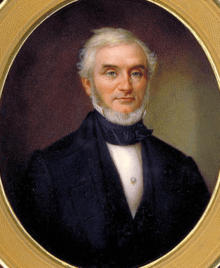James Augustus Suydam
James Augustus Suydam (March 27, 1819 – September 15, 1865), was an American architect, lawyer, and artist; as an artist was considered one of the premier Luminism painters. He is widely known as an American landscape painter and one of the leading members of the Hudson River School.
James A. Suydam | |
|---|---|
 | |
| Born | James Augustus Suydam March 27, 1819 |
| Died | September 15, 1865 (aged 46) |
| Alma mater | University of the City of New York |
| Known for | Landscape |
| Movement | Hudson River School; National Academy of Design |
Early life
James Augustus Suydam was born on March 27, 1819 and was descended from an old New York Dutch merchant family.[1] His parents were Jane (née Mesier) Suydam and John Suydam, who was considered "one of the old Knickerbocker merchants" and was head of Suydam & Wycoff, along with his brothers Henry P. M. Suydam and D. Lydig Suydam.[2]. His brother, John Richard Suydam, was the father of Jane Mesier Suydam, who married cousin Walter Lispenard Suydam.[2]
He graduated from New York University (then the University of the City of New York), and began his career as a businessman but turned a significant portion of his energies to painting, studying under famed artist and portrait painter [3] Minor C. Kellogg.[4] At the age of thirty he was elected to the Century Association.
One of the "regulars" who gathered to paint at North Conway, New Hampshire, he exhibited Conway Meadows at the New York Athenaeum and Boston Athenaeum. He opened his studio at the noted 10th Street Studio Building, New York City, in 1858. The following year he was elected an honorary professional member in the prestigious National Academy of Design, which granted him full membership in 1861.
He died suddenly in North Conway at the age of 46.[5] The posthumous sale of his estate revealed that he owned works by "old masters such as Rembrandt, Dürer, Ostade, and Raphael and contemporaries including Rosa Bonheur, Ary Scheffer, and George Caleb Bingham."[6] In his will,[7] he left $50,000 (equivalent to $835,109 today) to the National Academy along with his collection of 92 paintings including works by Frederick E. Church, John F. Kensett, Charles Edouard Frère, and Andreas Achenbach.[6]
Paintings

James Suydam was described by his friend, the accomplished artist Sanford Robinson Gifford as a "thoroughly educated and accomplished man."[8] In addition to his work as an artist, which he began only after working in law and architecture, he was widely read and well-versed in history, philosophy, and the sciences. His work as a landscape painter reflects this breadth of knowledge and reveals Suydam as a deeply spiritual individual. Using his familiarity with science, Suydam reduced nature to calm, clean, planar forms, and then distorted proportional relations so that God's creations loomed superior over the work of man.
The National Academy has most of his works such as Paradise Rocks (1865), and the Taft family's Taft Museum also holds works. The Taft also has a podcast website for this artist.[9]
A painting of Gifford's from 1859 which Suydam, according to a report, "donated to the [National] academy in 1865," became the subject of a deaccession controversy at the Academy in late 2008.[10][11]
Legacy
In 2006, a retrospective of Suydam's work was held at the National Academy Museum.[12]
References
- Genealogical Record of the Saint Nicholas Society of the City of New. The Saint Nicholas Society of the City of New York. 1905. p. 156. Retrieved 2 April 2019.
- "JOHN R. SUYDAM" (PDF). The New York Times. May 16, 1882. Retrieved 22 May 2018.
- American Art Colonies, 1850-1930, Steve Shipp (Greenwood Publishing Group, 1996) p. 69.
- NYU release
- "Funeral of James A. Suydam". The New York Times. September 20, 1865. p. 8. Retrieved 2 April 2019.
- Metropolitan Museum of Art (New York N.Y.) (2000). Art and the Empire City: New York, 1825-1861. Metropolitan Museum of Art. p. 92. ISBN 9780870999574. Retrieved 2 April 2019.
- "News Paragraph". Vermont Record. October 21, 1865. p. 5. Retrieved 2 April 2019.
- White Mountain Art biography Archived 2007-09-27 at the Wayback Machine
- Taft Museum Web site Archived 2007-07-02 at the Wayback Machine
- "National Academy Sells Two Hudson River School Paintings to Bolster Its Finances" by Randy Kennedy, The New York Times, December 6, 2008, p. C1, NY edition. Retrieved 1/13/09.
- Section on Mt. Mansfield paintings/controversy.
- Genocchio, Benjamin (September 15, 2006). "A Pioneer of the Poetry in Landscapes". The New York Times. Retrieved 26 March 2013.
External links
| Wikimedia Commons has media related to James Augustus Suydam. |
- Hudson River school visions: the landscapes of Sanford R. Gifford, an exhibition catalog from The Metropolitan Museum of Art (fully available online as PDF), which contains material on Suydam (see index)